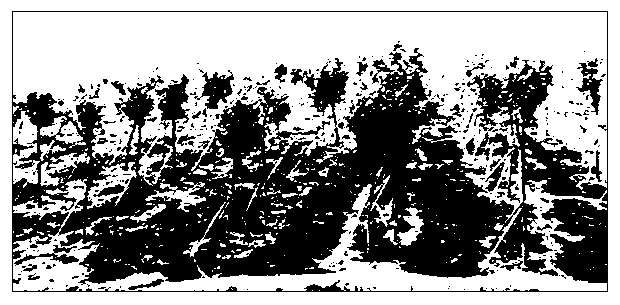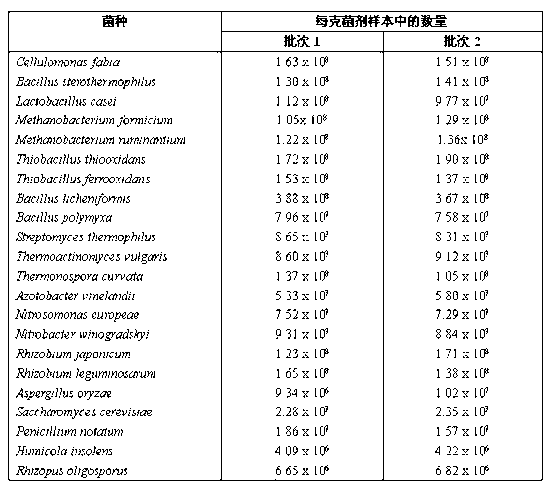Microbial agent and application of same in saline land improvement
A technology of microbial inoculum and saline-alkali soil, applied in the field of microbial fermentation
- Summary
- Abstract
- Description
- Claims
- Application Information
AI Technical Summary
Problems solved by technology
Method used
Image
Examples
Embodiment 1
[0061] The production of embodiment 1 microbial bacterial agent
[0062] The present embodiment uses the following strains to prepare microbial inoculum: (1) Cellulomonas faeci ( Cellulomonas fabia ), (2) Bacillus stearothermophilus ( Bacillus sterothermophilus ), (3) Lactobacillus casei ( Lactobacillus casei ), (4) Methanobacter ants ( Methanobacterium formicium ), (5) Methanobacter ruminantum ( Methanobacterium ruminantium ), (6) Thiobacillus thiooxidans ( Thiobacillus thiooxidans ), (7) Thiobacillus ferrooxidans ( Thiobacillus ferrooxidans ), (8) Bacillus licheniformis ( Bacillus licheniformis ), (9) Bacillus polymyxa ( Bacillus polymyxa ), (10) Streptomyces thermophilus ( Streptomyces thermophilus ), (11) common high temperature actinomycetes ( Thermoactinomyces vulgaris ), (12) Thermomonospora curved ( Thermonospora curvata ), (13) brown nitrogen-fixing bacteria ( Azotobacter vinelandii ), (14) Nitrosomonas europeanum ( Nitrosomonas europeae ), ...
Embodiment 2
[0065] Example 2 Production of saline-alkali soil improver
[0066] Take cow dung with a water content of 65% (weight ratio) (if the water content is insufficient, you can add water) and crushed rice bran with particles smaller than 5mm, mix them evenly at a mass ratio of 85:15, and make the mixed cow dung and rice bran There is no agglomeration above 40mm.
[0067] Then, the mixture of 1 ton of above-mentioned cow dung and rice bran is mixed with the microbial inoculant produced in 1kg of Example 1, and heaped into the fermenter to form a compost heap. During the compost heap placement period, along with the fermentation process, the compost heap can naturally heat up. This fermentation heating process usually takes 2-3 days, and the compost heap can be turned 1-2 times during this period. Then, when the temperature of the compost heap rises to 65°C, turn on the turner to turn the compost heap to dissipate the heat generated by fermentation to ensure that the temperature d...
Embodiment 3
[0070] Example 3 Improvement example of saline-alkali land in Tianjin Binhai New Area
[0071] Tianjin Binhai New Area is located on the west coast of Bohai Bay and has the entire 154-kilometer coastline of Tianjin. The terrain in this area is flat (the slope is 1 / 10000 to 1 / 10000), the altitude is only 1 to 2.5 meters, and the soil is compact; the water level of the surface pore water (groundwater) is only 0.5 to 1.0 meters, and the salinity is greater than 30 grams per liter; saline-alkali land accounts for 86.3% of the total land area, with sparse vegetation, high soil salinity, difficulty in soil desalination, and fragile ecosystems, which are considered "forbidden areas for plants".
PUM
 Login to View More
Login to View More Abstract
Description
Claims
Application Information
 Login to View More
Login to View More - R&D
- Intellectual Property
- Life Sciences
- Materials
- Tech Scout
- Unparalleled Data Quality
- Higher Quality Content
- 60% Fewer Hallucinations
Browse by: Latest US Patents, China's latest patents, Technical Efficacy Thesaurus, Application Domain, Technology Topic, Popular Technical Reports.
© 2025 PatSnap. All rights reserved.Legal|Privacy policy|Modern Slavery Act Transparency Statement|Sitemap|About US| Contact US: help@patsnap.com


